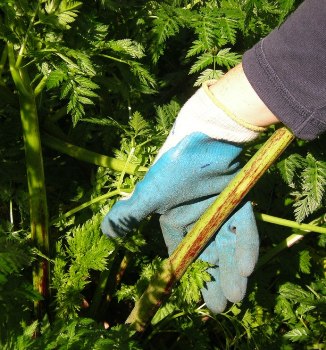I found the following at the OSU website. I had been hearing more and more about poison hemlock and how people confuse it with Queen Anne's Lace. The consequences of getting this on your skin is worse than poison ivy.
Poison-hemlock
Poison-hemlock is acutely toxic to people and animals. Unrelated to
the native evergreen hemlock tree, poison-hemlock can be deadly; it has gained
notoriety through its use in the state execution of Socrates.Poison-hemlock can be confused with wild carrot (Daucus carota, or Queen Anne's Lace), as with many other members of the parsley family that resemble it. It has hairless hollow stalks with purple blotches. It can get quite tall, sometimes up to 8 feet or higher. It produces many umbrella-shaped flower clusters in an open and branching inflorescense. In contrast, wild carrot has one dense flower cluster on a narrow, hairy stem, usually with one purple flower in the center of the flower cluster, and is usually 3 feet tall or less. Poison-hemlock starts growing in the spring time, producing flowers in late spring, while wild carrot produces flowers later in the summer.
Toxicity
 Poison-hemlock
is acutely toxic to people and animals, with symptoms appearing 20 minutes to
three hours after ingestion. All parts of the plant are poisonous and even the
dead canes remain toxic for up to three years. The amount of toxin varies and
tends to be higher in sunny areas. Eating the plant is the main danger, but it
is also toxic to the skin and respiratory system. When digging or mowing large
amounts of poison-hemlock, it is best to wear gloves and a mask or take frequent
breaks to avoid becoming ill. One individual had a severe reaction after
pulling plants on a hot day because the toxins were absorbed into her skin. The
typical symptoms for humans include dilation of the pupils, dizziness, and
trembling followed by slowing of the heartbeat, paralysis of the central nervous
system, muscle paralysis, and death due to respiratory failure. For animals,
symptoms include nervous trembling, salivation, lack of coordination, pupil
dilation, rapid weak pulse, respiratory paralysis, coma, and sometimes death.
For both people and animals, quick treatment can reverse the harm and typically
there aren’t noticeable aftereffects. If you suspect poisoning from this plant,
call for help immediately because the toxins are fast-acting – for people, call
poison-control at 1-800-222-1222 or for animals, call your veterinarian.
Poison-hemlock
is acutely toxic to people and animals, with symptoms appearing 20 minutes to
three hours after ingestion. All parts of the plant are poisonous and even the
dead canes remain toxic for up to three years. The amount of toxin varies and
tends to be higher in sunny areas. Eating the plant is the main danger, but it
is also toxic to the skin and respiratory system. When digging or mowing large
amounts of poison-hemlock, it is best to wear gloves and a mask or take frequent
breaks to avoid becoming ill. One individual had a severe reaction after
pulling plants on a hot day because the toxins were absorbed into her skin. The
typical symptoms for humans include dilation of the pupils, dizziness, and
trembling followed by slowing of the heartbeat, paralysis of the central nervous
system, muscle paralysis, and death due to respiratory failure. For animals,
symptoms include nervous trembling, salivation, lack of coordination, pupil
dilation, rapid weak pulse, respiratory paralysis, coma, and sometimes death.
For both people and animals, quick treatment can reverse the harm and typically
there aren’t noticeable aftereffects. If you suspect poisoning from this plant,
call for help immediately because the toxins are fast-acting – for people, call
poison-control at 1-800-222-1222 or for animals, call your veterinarian.
Thanks for sharing.
ReplyDelete